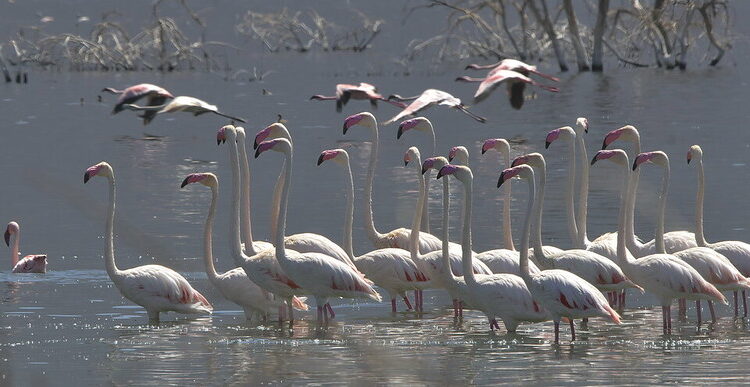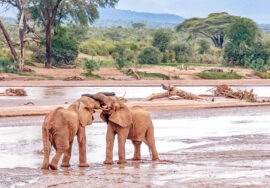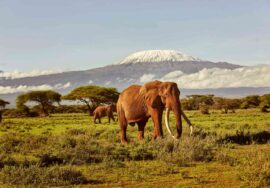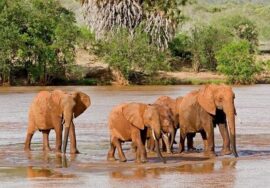
LAKE BOGORIA NATIONAL RESERVE
LAKE BOGORIA NATIONAL RESERVE, Imagine a lake high in the mountains in a volcanic area close to the equator that is full of bright pink flamingos all the time. There are hot springs all around this lake and in the surrounding areas that make the already dreamy atmosphere even better. On top of that, you can see many bubbling geysers exploding along the lake’s edges and from inside it.
You’re about to see something that you’ll never see anywhere else. That something is Lake Bogoria National Reserve.
But as interesting as the scene in front of you looks, Lake Bogoria is not a very popular place to visit. If you go early in the day, there won’t be many other people there. You and up to two million flamingos.
The lake is very salty and alkaline, which helps blue-green algae grow. These algae are food for huge groups of flamingos. Raptors, like tawny eagles, are drawn to this area to hunt the flamingos. This is how nature works. There is a full and beautiful ecosystem in front of you.
But flamingos aren’t the only birds that eat the plants and animals that live in this area. There are 135 different kinds of birds that live in this relatively small area. These include the sacred ibis, spoonbill buzzards, hornbills, herons, ostriches, and storks.
The seashore is mostly empty because the water is very chemically active, but a lot of different kinds of animals live there. Along the banks, it’s easy to see kudu deer. At the southern end, there is an acacia forest where buffalo, klipspringer, impala, zebra, gazelle, warthog, monkey, and even leopard live.
A Geothermal Heaven
In addition to the beautiful show of fuchsia-colored lesser flamingos and a few larger flamingos that cover the lake, the area has more than 200 hot volcanic springs. Some of these flow into the lake floor, while most of them are next to the lake.
Up to 10 geysers can be seen in different places around and inside the lake. Their plumes can reach heights of up to 5 meters (16 feet). There are 18 geysers in the park, which is more than any other place in Africa.
The area is great to explore on foot or by bike because it has amazing displays of wildlife and dramatic geyser eruptions that show off nature’s power.
About the Reserve of Lake Bogoria
The lake is 34sq. km (13sq. mi) and the park is 107sq. km (41sq. mi). The area is about 1 mile (1.5 km) above sea level.
Place: Lake Bogoria is 239 km (148 mi) northwest of Nairobi, just south of the equator.
Weather: The normal daytime temperature is 28oC/82oF, but it can get cool at night. It doesn’t rain much from September to May, but it does rain sometimes in January and February.
When there are lots of flamingos is the best time to go. Many of the birds come when the lake is low, which is in August through October. This isn’t always expected, which is a shame. The good news is that these bright pink birds will usually come in large groups to the lake most of the time.
When it’s Open: The reserve is open early, from 8:00 AM to 5:00 PM.
For getting there, you can book a trip with African Safari Kenya from Nairobi. The drive takes about 4 and a half hours.
By air: There are no trips from the United States to Lake Bogoria.
Things to Do and See Look at Flamingos
There is nothing more beautiful than seeing tens of thousands or even millions of pink flamingos in a small lake. When you get close, the birds will move away to protect themselves, but after you sit down for a while, they’ll move back like a nice pastel picture. Usually, the best pictures are taken early in the morning or late at night.
The bike
It’s fun to ride a bike around the lake and see all the different kinds of plants and animals that live here. As you ride your bike, you’ll see hot springs and geysers that are boiling.
Put an egg in water.
Would you like to cook at the lake? Women from the area sell raw eggs to people who are just outside the reserve. You can add your egg to the hot springs and cook it yourself. It can be hard-boiled or soft-boiled.
The Kesubo Swamp
In the north, just outside of Lake Bogoria is Kesubo Swamp, a great place to watch birds. People have seen more than 200 species here.
Lake Baringo
There is a freshwater lake called Lake Baringo just north of Bogoria. It is home to many bird species. Bear, owl, and hornbill are birds to look for. As well as hippos and crocs.
Check out Lake Bogoria National Reserve.
Few people have been to Lake Bogoria, but many have seen amazing pictures of it. Its shores are wild and empty, and it is full of colorful birds. You can get close to this reserve’s seas of flamingos, steaming hot springs, and geysers that explode.
African Safari Kenya can take you to this unique and amazing place that is only a short drive from Nairobi. For your trip to Africa, we offer tours that leave from Nairobi and go to this and other unique Kenyan parks.








